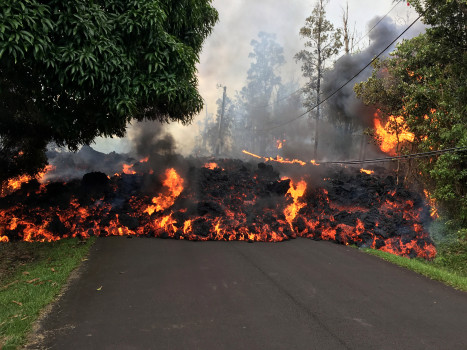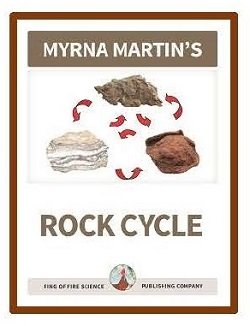Volcanoes create igneous rocks
What are igneous rocks
The term igneous rocks is from the Greek word for fire. All volcano rocks are igneous rocks because they form from hot, molten rock that originated deep within the Earth at tectonic plate boundaries.
Four major groups of igneous rocks
There are four major groups of the igneous rocks: basalt, andesite,
dacite and rhyolite. Each of these different rock groups form different types of volcanoes.
Basalt covers the ocean floors and creates shield volcanoes.
Andesite forms in subduction zones creating stratovolcanoes.
Dacite is a thick pasty lava that creates lava domes and small dome volcanoes.
Rhyolite is associated with supervolcanoes and large Plinian eruptions.

Basalt volcanic rocks forming during an eruption on Kilauea, USGS
Rhyolite
Rhyolite rocks
Rhyolite magma cooling underground forms granite. Granite has large
interlocking crystals that can be easily seen if you hold the rock at
arm's length.
Supervolcano eruptions
Rhyolite is associated supervolcanoes and explosive
volcanic eruptions that create calderas. During these violent eruptions the summit of the volcano collapses or is blown away during the eruption.
Basalt
Basalt rocks
Basalt rocks are formed from dark heavy lava that forms in the
upper mantle. Pillow basalt covers all the ocean floors. It forms when
lava erupts on the ocean floor at spreading ridges where two crustal
plates are separating.
Seamounts and knolls
Seamounts are shield volcanoes over 1000 m tall. Smaller volcanoes less than 1000 m high are called knolls. Seamounts and shield volcanoes found on the ocean floors are all basalt volcanoes from the upper mantle. The


Click for More Information or to Order
andesite
Andesite rocks
Andesite lava forms in subduction zones where an oceanic plate is
subducting beneath a continental plate. The lava erupts on the
continental side of the subduction zone forming a large composite
volcano. Composite volcanoes are also known as stratovolcanoes and they usually alternate between explosive eruptions and thick lava flows on the side of the volcanoes.
Examples of composite volcanoes
Mt. Hood, Mt. Rainier and Mt. Spurr. These great composite volcanoes
usually have layers or tephra alternating with layers of thick lava
flows. The lava was named for the Andes Mountains in South America.
dacite
Dacite rocks
Dacite contains less quartz than rhyolite lava and more than andesite lava. The lava when it flows out a a volcano vent is so "sticky" that it piles on top of a volcano's vent forming a dome.
Lava domes
Lava domes often form in the craters of stratovolcanoes like Mount Saint Helens. Lassen Peak in California is an example of the summit of a volcano that is dacite.
Groups of dacite domes
Small dacite domes form in groups. The exterior of a dacite dome is crumbly because the lava is so thick it breaks the outside layer of rocks apart as new lava pushes upward from the vent of the volcano.
KIDS FUN Science Bookstore
Check out Myrna Martin's award winning textbooks, e-books, videos and rock sets. The Kids Fun Science Bookstore covers a wide range of earth science topics. Click here to browse.










